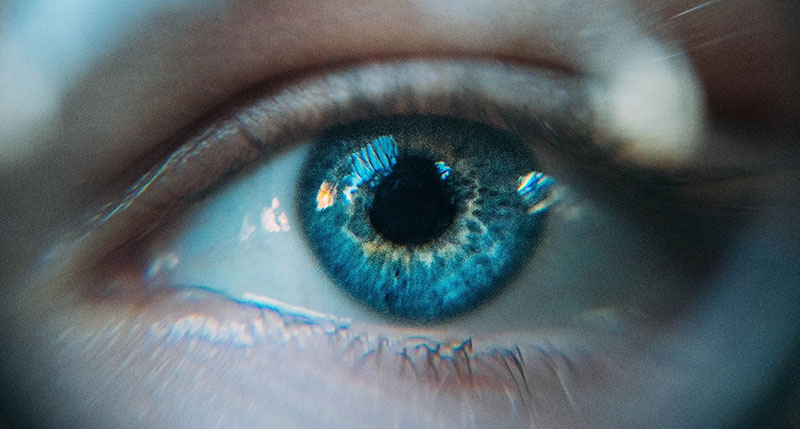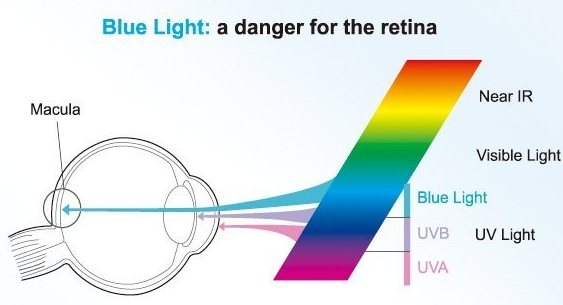In the current digital world, we are surrounded by screens like smartphones, computers, tablets, and televisions all around us. Such devices emit blue rays, which are very harmful to our eyes, that can strain our eyes and later lead to discomfort. Though blue
Light is not fully harmful yet long-time exposure to blue lights can cause digital eye strain, headaches, and even affect our sleep cycles. So, what’s the way? How can you protect your eyes from blue light exposures? Let’s dive and discuss the best possible ways that experts recommend.

1. Using Blue Light Filters
Blue light filters, also known as blue-light-blocking glasses, may offer benefits like
reducing eye strain and improving sleep. Their main purpose is to filter out blue lights emitted from digital screens, which may cause eye discomfort.
Here’s how blue light filters can help:
● Reducing glare and light sensitivity: Blue light glasses can protect your eyes by reducing glare and light sensitivity, hence relaxing strain and also improving blink rate.
● Improves Sleep: Blocking of blue light can help you maintain normal circadian rhythms hence improving your sleep.
● Reducing eye strain: As blue light can contribute to eye strain thus protecting your eyes from blue light can give comfort to your eyes.
● Improving vision quality: They improve contrast and quality of vision by reducing computer screen glare

2. Invest in Blue Light Blocking Glasses
Blue light-blocking glasses are built to filter out blue light emitted from digital screens hence potentially reducing eye strain and improving sleep.
Here are some of the positive effects:
● May promote healthy sleep: Blue light-blocking glasses can help you improve sleep, reducing sleep latency of the people who suffer from sleep disorders or inconsistent work schedules.
● May reduce light sensitivity: By stopping the artificial blue lights from electronic device,s it can help you get rid of headaches and light-sensitive eyes.
● May decrease symptoms of dry eye: Reducing glare and light sensitivity can help relax strain and improve blink rate, which can reduce dry eye symptoms.
● Improving contrast and quality of vision: They improve contrast and quality of vision by reducing computer screen glare. The ideal blue light-blocking glasses should include an anti-glare coating to provide extra protection against digital eye strain.
● Other benefits: Some sources suggest blue light glasses can also increase alertness and may help manage depression and anxiety.
3. Follow the 20-20-20 Rule
In this digital age, the 20-20-20 rule can help you very effectively eradicate eye strain and promote better eye health. It involves taking a 20-second break every 20 minutes to focus on something 20 feet away. Practicing this can help you reduce eye strain and
discomfort associated with prolonged screen time.
Some Positive effects of following the 20-20-20 rule:
● Eye Muscle Relaxation: It helps in relaxing the eye muscles that help in adjusting the focus and reducing eye strain.
● Maintained Tear Production: Helps in preventing dry eyes.
● Increased Productivity: Regular breaks can improve focus by preventing mental fatigue and sustaining visual comfort.
● Better Eye Health: Taking care of your eyes and preventing eye strain contributes
to long-term eye health.
● Enhanced Sleep Patterns: This rule can help you with the sleep-wake cycle and improve sleep quality.
● Minimize Risks: Minimizes the risks of prolonged straining eyes.
4. Adjust Screen Brightness and Contrast
Adjusting the screen brightness and contrast is suggested to reduce eye strain. Matching screen brightness to the surrounding ambient light prevents eyes from overexerting, reducing discomfort and fatigue. During the day, it’s best to reduce brightness to minimize glare, while at night, a slight increase can help viewing in low light.
Benefits of adjusting brightness and contrast:
● Reduces eye strain: Adjusting brightness with the ambient light can help in preventing overexertion.
● Improves readability: Proper contrast enhances the distinction of text and images, making them easier to view.
● Minimizes blue light exposure: Lowering brightness and using warmer color temperatures can also help in reducing the blue light.
● Promotes comfortable viewing: Overall adjustments create a more comfortable viewing experience, reducing the risk of eye strain and fatigue.
5. Maintain Proper Distance and Posture
Maintaining proper screen distance and posture is essential in protecting your eyes from strain and long-term vision issues. As per experts, the recommended distance
between your eyes and screen should be 20-30 inches(50-76 centimeters). This is the range
that allows your eye muscles to relax by reducing fatigue caused by long-term
screen focus. Also, positioning the top of the screen at or slightly below eye level helps prevent dry eye and minimizes neck and shoulder strain. Good posture, with your neck and torso vertically aligned and feet flat on the floor, will help you in comfortable viewing.
Key benefits of proper screen distance and posture: ● Promotes Better Posture: Correct posture reduces strain on your neck, shoulders, and back, contributing to overall comfort during screen use.
● Prevents Myopia and Digital Eye Strain: Keeping an optimum distance can be useful in preventing Myopia, especially for younger users.
● Supports Comfortable Viewing: Overall adjustments create a more comfortable viewing experience, reducing the risk of eye strain and fatigue.
6. Take Frequent Breaks
We know sometimes due to the workload and pressure you may forget to take adequate breaks in between. But, taking breaks in between has some long-term benefits.
Long hours of screen time can make your eyes dry and fatigued. Taking regular breaks, blinking consciously, and using artificial tears if needed can help maintain moisture in your eyes.
7. Improve Your Diet for Eye Health
Improving your diet with specific nutrients and antioxidants can help protect your eyes from blue light exposure. Lutein and zeaxanthin, found in high concentrations in the retina, act as a natural defense system by filtering harmful blue light and reducing oxidative stress. Consuming enough vitamins A, C, and E, minerals like zinc, and antioxidants may also boost your eye health.
Key points on how diet improves eye health and protects against blue light:
● Lutein and Zeaxanthin: These carotenoids act as internal sunglasses, filtering out harmful blue light and keeping eye cells healthy. Good sources
include leafy greens like spinach and kale, as well as egg yolks.
● Vitamins C and E: These vitamins serve as protective shields, guarding against harmful free radicals and reducing oxidative stress that damages eye cells. Vitamin C sources include oranges, grapefruits, and strawberries, while Vitamin E can be found in almonds, sunflower seeds, and olive oil.
● Zinc: Vital for maintaining the retina’s health and may protect against light-induced damage. Sources include legumes, seeds, meat, seafood, dairy, and eggs.
● Omega-3 Fatty Acids: The long-chain omega-3 fatty acids EPA and DHA are
important for eye health. Your Retina contains high amounts of DHA. Research shows that omega-3 supplements may benefit those with dry eye disease.
● Vitamin A: Crucial for keeping the eye’s retina, the light-sensitive part, functioning well. Orange fruits and vegetables like carrots and sweet potatoes are high in
beta-carotene, a type of vitamin A.
8. Get Regular Eye Check-ups
Regular eye checkups are essential for maintaining overall eye health and can indirectly help protect your eyes from the effects of blue light exposure. These exams allow for
the early detection of eye conditions that may be worsened by blue light, such as
cataracts and age-related macular degeneration. Furthermore, eye doctors can provide advice on managing digital eye strain and recommend appropriate measures like blue light filtering lenses or screen adjustments.
Key reasons why regular eye checkups are important:
● Early Detection of Eye Diseases: Regular exams can detect eye disorders like glaucoma, cataracts, and age-related problems early on when they are simpler to manage and treat.
● Prevention of Eye Strain: Ophthalmologists can identify symptoms of eye strain caused by digital device use and thus recommend preventative measures.
● Better Visual Function: Routine check-ups ensure peak performance by checking both near and far vision.
● Assessment of Risks: Ophthalmologists check for common vision abnormalities like nearsightedness and farsightedness.
● Check for Potential Blindness: Early detection can prevent blindness in over 75% of cases. In today’s digital world, protecting your eyes from blue light exposure is essential. By following simple effective strategies like using blue light filters, maintaining proper screen brightness, practicing the 20-20-20 rule, and improving your diet, you can safeguard your vision and reduce eye strain. Regular eye check-ups also play a vital role in detecting and preventing long-term eye issues. When it comes to safeguarding your vision, choosing the best eye hospital in Kolkata, such as Netralayam, Shankar Netralaya, or Pushpanjali Eye Care ensures the best care and advanced treatments. Whether you’re struggling with digital eye strain or need expert guidance for long-term eye health, consulting experienced ophthalmologists can make all the difference. Prioritize your eye health today and seek expert consultation for comprehensive care!

Jean Smith is a fitness enthusiast and blogger who focuses on fitness and a healthy lifestyle. She is passionate about assisting people in living healthier lifestyles and is constantly on the lookout for new and creative methods to stay fit and healthy. Her articles are excellent resources for anyone interested in improving their health and fitness.
